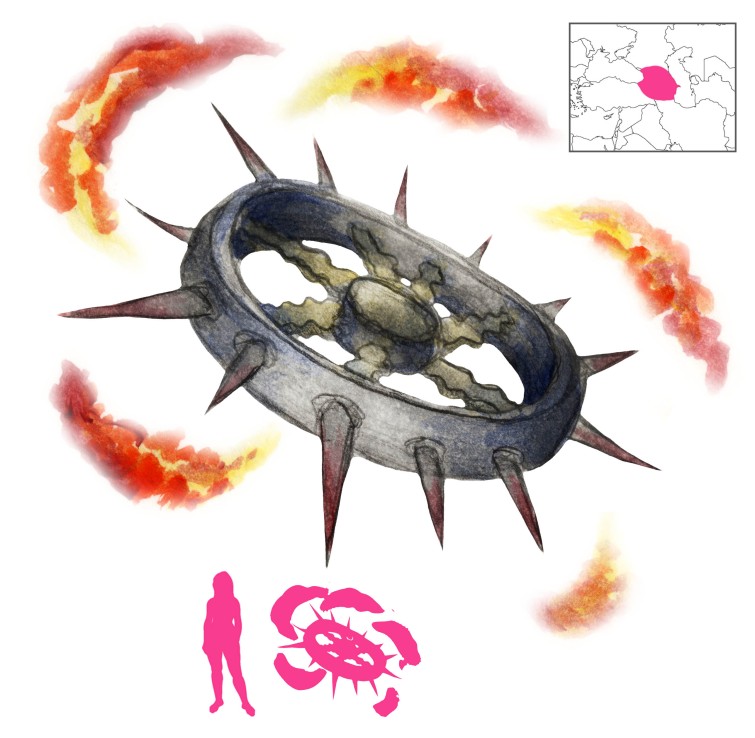Variations: Wheel of Balsæg/Barsæg/Barsag/Balsag/Marsug/Father Ojnon, Thinking Wheel, Cutting Wheel
When Soslan or Sosryko, greatest of the Nart heroes, was born, his mother had him dipped in magical fire. The process rendered him immortal and invulnerable, but alas, the smith’s tongs had held him by the knees, which became his only weak spot.
After many adventures, Soslan was finally defeated by the jealous Syrdon. Aware of the hero’s weakness, Syrdon incited the devils to fire their arrows from below ground into his horse’s hooves. Like its master, the horse had only one weak spot, in this case the underside of its hooves.
Once the horse fell, Syrdon called upon the enigmatic Barcädžy Calh, the Wheel of Balsæg or Cutting Wheel. The Wheel was a Thinking Machine, an intelligent and malevolent automaton that took the form of a razor-sharp metal wheel with steel teeth and flames bursting from it. It came rolling down from the heavens to the Earth, setting fire to plains and forests as it went on its headlong charge to the Black Sea. Only birch trees managed to avoid the flaming Wheel’s wrath. Soslan gave chase to it and captured it, but it escaped his grasp, flew at him, and sliced through his knees, leaving him for dead. The hero’s sons chased the Wheel back into the Black Sea, but it was already too late. The Narts buried him as he died; his last act from the grave was the impalement of Syrdon. Soslan’s nephew avenged him by breaking the Wheel in half.
Balsæg, also known as Barsæg, Marsug, and permutations thereof, remains unknown. Knowledge of his nature has been lost, save that he is the proprietor of the Wheel. In some accounts, the Daughter of the Sun sends the Wheel to kill Soslan; in others, it belongs to Father Ojnon – John the Baptist. It may have its origin as a solar symbol or accessory in solstice rituals. Finally, in some retellings the Wheel is reduced to a mere training discus, albeit a very sharp one. Soslan is tricked into bouncing it off his weak spot.
References
Cayla, F.; Quesnel, A.; Welply, M.; and Laverdet, M. (1997) Le guide illustré des mythes et légendes. Hachette, Paris.
Colarusso, J. (2002) Nart Sagas from the Caucasus. Princeton University Press.
Dumézil, G. (1978) Romans de Scythie et d’alentour. Bibliothèque Historique, Payot, Paris.
Littleton, C. S. (1979) The Holy Grail, the Cauldron of Annwn, and the Nartyamonga: A Further Note on the Sarmatian Connection. The Journal of American Folklore, vol. 92, no. 365, pp. 326-333.

Pingback: Goodbye to Ghosts – Mechanical Owl